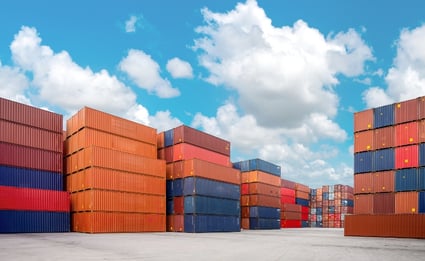5 Things to Monitor in Your Supply Chain
Jesse Kelber - December 12, 2019

Wouldn’t it be nice if supply chains could run themselves? Well, between automated scheduling, production machinery, and even logistics planning, you can achieve a fair approximation using the right tools. Even so, there are plenty of places along the value chain where things can go sideways. The headaches may be less frequent, but they are no less real. No matter how seemingly care-free your supply chain, there are aspects you’ll want to closely monitor to ensure that smooth running continues. Crucial to each of these is the visibility into your processes that comes with Industry 4.0 technology and a solid supply chain management solution.
To ensure the continued operation of your newly streamlined chain, you need to be able to see into each stage along the way. From the mine where your raw materials start their journey, through your facility, and all the way to the customer’s door. Today we’re drilling down into this end-to-end visibility and pulling out five specific areas of the supply chain that you should have a firm handle on. There’s a mix of concrete items, like spending in certain areas, and some broader items, like suggestions for keeping an eye on your supplier’s performance. When it comes to the bottom line, you need to blend concern for ROI with concern for the customer’s experience, then add in a good amount of watchfulness over the entire supply chain to achieve the results you need. Use these five areas as your starting point, and you’ll be well on your way.
1. Suppliers and Other Up-Stream Partners
How much transparency is there into your up-stream suppliers’ processes? Are they using Industry 4.0 technology to help power their own supply chains? If so, can you integrate your systems with theirs? This will give you the visibility you need to be able to adjust production runs and shuffle inventory to better match your incoming supply orders. If this level of integration isn’t possible, cultivate deeper relationships with your partners and their planners. This way, should a disruption become apparent to them, they’re far more likely to pick up the phone and alert you. This kind of working relationship can keep things moving smoothly until further integration becomes possible.
2. Production Line Maintenance Needs
Industry 4.0 technology like IoT sensors connected to your production equipment is a major step toward a self-regulating supply chain. These internet-enabled sensors report back to your management console on the health status of your production line. Then the AI-backed advanced analytics in your SCM solution can alert you to possible upcoming repair needs before they cause unplanned downtime. By conducting this type of predictive analysis and maintenance during pre-scheduled lulls in production, you can avoid costly delays and keep your factory cranking out widgets on schedule.
3. Warehousing Costs
A large source of sunk costs in many supply chains is unused warehouse space. The causes range from inaccurate demand forecasting, to customers changing orders mid-run, to the unplanned production floor downtime discussed above. RFID tracking chips, smart pallets, and GPS enabled forklifts combine to streamline the warehousing process. This technology allows you to better position inventory for quick locating and loading when the order is being shipped, and to better take up the slack should one of those other disruptions occur. Knowing the precise location of all warehouse assets, from individual order pallets to each forklift lets you make on-the-fly adjustments to speed up both the intake of new supplies and the readying of orders to ship to customers. To take things a step further, you can also integrate these tracking abilities with your IoT sensors and shipment tracking tools; this can lead to drastic cuts in linear shelf space requirements since you won’t have inventory sitting around as long.
4. Logistics Flexibility
The last of the concrete areas to keep an eye on, logistics is a major source of disruptions and cost overruns for most supply chains. These issues arise from multiple directions: unpredictable weather patterns, fuel price spikes, and natural disasters, to name but a few. Sensors in your shipments can relay data from environmental conditions to the pitch and yaw of your goods. Together with GPS tracking, this technology can let you make course corrections and route changes mid-shipment. With the same sensors installed on your trucks, you can even send new routes to each rig to direct them around traffic snarls or toward less expensive fuel stops.
5. Metrics
With all this technology comes a lot of data. Therefore, our last thing to monitor in your supply chain is a broader category—metrics. Since every supply chain is different and unique to its business, we’re going to steer clear of giving advice on KPIs, instead keeping our suggestions to four categories of metrics to monitor.
Perfect order
This is a go-to metric when you need a quick snapshot of the overall health of your manufacturing concern. Perfect order is exactly what it sounds like, generally represented as the percentage of orders that are complete with no re-orders, no missing items, and on-time delivery.
Order cycle time
This metric looks at the elapsed time from when a customer places an order to when it hits their door. Variations exist, of course, with some companies looking at time between individual orders from one client, or having a different definition of when an order starts (when it’s placed vs when production starts, for example). Set your own KPI, then monitor it to get a handle on your production facility’s effectiveness.
Inventory carry rate
When you want to know how long orders are sitting in the warehouse taking up valuable space while possibly delaying the order’s final delivery, this is the metric to look at. This is also the metric to go to when you’re monitoring #3 on our list, warehousing costs. The amount of inventory that’s sitting dormant tells you how well your warehouse is doing at keeping orders together and how efficient operations are.
Forecast accuracy
Perhaps the most flexible of our suggested metrics, there are many different KPIs this can refer to. Our pick is MAPE, or mean absolute percentage error, as this gives the clearest look at the functional accuracy of your demand forecasts. MAPE is also a fantastic metric to use when you need a snapshot of your S&OP process.
If you want to learn more get your Guide to Industry 4.0:
LATEST POSTS
- Understand Circular Economy in The Manufacturing Industry
- How Can Industry 4.0 IT Integration Be Achieved Smoothly?
- The Significance of Order Sequencing in Discrete Manufacturing
- How to improve your Supply Chain Management: The Power of Control Towers
- Optimizing Human Resource Scheduling in Manufacturing: A Technological Approach



